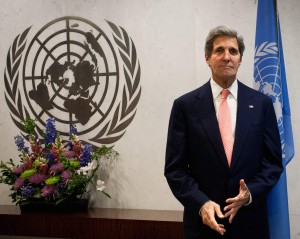 by Dr. Laurie Ann Mylroie
by Dr. Laurie Ann Mylroie
President Obama’s handling of the Gaza conflict marks a sharp break with his attitude toward other Middle East conflicts, as well as the policies of previous U.S. presidents. In contrast to Obama’s lethargic and indifferent response toward such calamities as the Syrian regime’s serial massacres of its own population or threats like the Islamic State’s consolidation of control over large swathes of Iraq and Syria, Obama is exercised about the conflict in Gaza, and he has shocked Israelis across the political spectrum with his demand—made Sunday in a phone conversation with Israeli Prime Minister Netanyahu—for an “immediate, unconditional, humanitarian” cease-fire. However, a cease-fire for whatever purpose has a determining impact on the military situation, and the cease-fire Obama demanded would have stopped the Israelis from achieving a key objective—the destruction of Hamas’ “terror tunnels.”
Hamas is a terrorist organization. The Clinton administration made that official determination nearly 20 years ago, and Hamas has remained on the State Department’s list of “Designated Foreign Terrorist Organizations” since. Hamas began the current round of fighting, firing rockets indiscriminately at Israeli population centers. Like other terrorist organizations, it is indifferent to civilian casualties, including its own—which is why it hides its fighters and weapons among the Palestinian population. And Hamas rejected the initial cease-fire proposal, made by Egypt two weeks ago—which Israel accepted. Indeed, a majority of Americans believe precisely this, according to the latest Pew Research Center poll. Americans think that Israel is justified in its war against Hamas, and twice as many say that Hamas is responsible for the violence, as say that Israel is responsible for it.
Yet last week Secretary of State John Kerry presented Israel a cease-fire proposal that was more favorable to Hamas than the original Egyptian draft. Above all, Kerry’s draft would not have allowed Israel to continue operations against the tunnels—which were discovered almost by accident, after Hamas rejected the Egyptian-proposed cease-fire and tried to use a tunnel to launch an attack on a kibbutz, where they intended mass slaughter. However, luck prevailed, as a passing army patrol stumbled upon the would-be assailants (who were wearing Israeli army uniforms, which would have facilitated their entry into the kibbutz.)
This encounter triggered Israel’s ground operation into Gaza, and the number, extent, and sophistication of the tunnels discovered since has taken the country by surprise. They represent “a resounding security failure,” Israeli officials say. Once the fighting ends, a commission of inquiry is likely to determine why the tunnels were not discovered much earlier.
Given the deep concern about Hamas’ tunnels, the Israeli cabinet unanimously rejected Kerry’s cease-fire proposal on Friday. Kerry then proceeded to Paris to meet the foreign ministers of two state supporters of Hamas—Turkey and Qatar (Iran is a third)—along with the French, British, and German foreign ministers. Neither Israel nor any other Arab party besides Qatar was invited to the unusual conference.
Hamas’ Qatari-based exiled leadership has taken a tougher line on a cease-fire than Hamas’ Gaza leadership. This gives oil-rich, pint-sized Qatar extra clout with the Obama administration, because Qatar presumably has influence over Hamas’ most radical elements, and Obama is very keen to reach a cease-fire in Gaza, as Washington Post columnist David Ignatius explained. The U.S. pandering to Qatar, Turkey, and Hamas has enraged much of the Middle East, uniting Israel, Egypt, Jordan, Saudi Arabia, and the Palestinian Authority in outrage at the bumbling diplomacy.
The U.S. cannot want a cease-fire more than both parties to the fight, and the appeasement of entities like Hamas does not work. It is short-term gain, but long-term pain. The cease-fire will only break down again, and soon. Besides, Israel’s leaders have affirmed their determination to continue their military campaign until the tunnels are neutralized, and they are backed in that decision by an overwhelming majority of Israelis.
Unfortunately, conflict between Israel and its neighbors is so routine that there is an established procedure for dealing with it, which has been followed by the past two U.S. administrations. Obama would do well to adopt it too. The cease-fire ending the current round of fighting is crucial. It is a big part of why the parties have fought, and it should not reward aggression. Rather, the terms of the cease-fire should aim to establish an enduring calm and a more stable situation than existed before the conflict erupted. To merely restore the status quo ante is insufficient, as it will break down again—and sooner, rather than later.
This goal is generally achieved by close co-ordination with Israel. Invariably, international pressure will build for a cease-fire. Part of the established U.S. role is to fend off that pressure for as long as possible to give the Israelis the time they need to achieve their military objectives. Then, as the cease-fire starts to take shape, the U.S. works to ensure that its terms will actually promote security, rather than insecurity.
The civilian deaths in the Gaza conflict are genuinely regrettable. Yet that is, above all, Hamas’ doing, and they would end, if Hamas accepted reasonable terms for a cease-fire. To push Israel to accept unreasonable terms will only lead to another round. This thinking is all very straightforward. The American public seems to understand it, so what problem do Obama and Kerry have?
. . . . . . . . . . . . . . .
Laurie Ann Mylroie, Ph.D. is a adjunct Senior Fellow with Frontiers of Freedom specializing in the Middle East. She has recently returned from Afghanistan where she provided cultural advice to the U.S. Military.